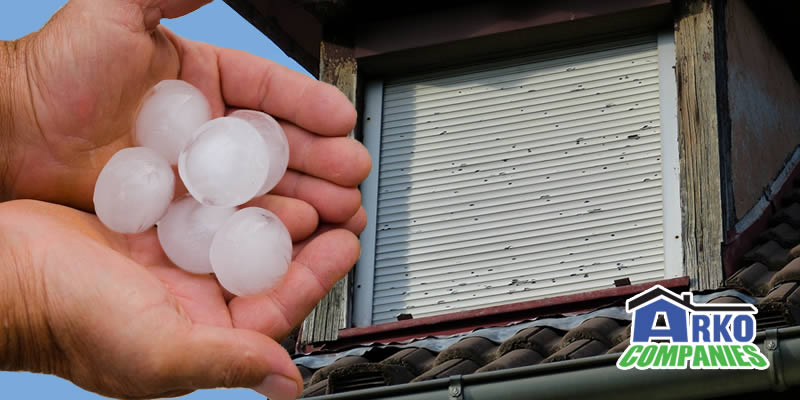People living in a hail-prone area are quite familiar with the damage caused by hailstorms.
Hailstorms occur due to natural climatic change and the severity of the damage is dependent on the size of the hailstones. A hailstone can be the size of a pea– or reach sizes close to a softball. Due to the fact that most hailstones do not have smooth edges, each one can inflict massive damage to roofs, buildings, and vehicles.
Experts agree hail damage can cause significant damage to your roof. Ignoring the damage caused to a roof after a hailstorm will only lead to bigger problems down the road.
What Are Some Of The Common Signs Of Hail Damage?
The severity of hail roof damage can vary according to several factors such as:
- The size of the hailstone
- The speed of the wind
- The direction of the wind
- The material used in the roof
- Age of the roof
- The sloping or inclination of the roof
All these aforementioned factors play an important role in causing damage to the roof during a hailstorm. Hail damage is especially bad for a roof when it causes major roof leaks and other issues.
The damage caused during a hailstorm can be functional or cosmetic. Functional roof damages are more severe than cosmetic damages because they disrupt the structural integrity of the roof. Roof damages like broken edges, bruises, punctures, and granule loss can cause serious complications, even though they may seem cosmetic at first.
Being a homeowner, it is important for you to assess the roof damages caused by hailstorms. Hail damage usually comes in various forms:
- Excessive Loose Shingle Granules: Hail can cause the little flecks of ceramic on shingles, otherwise known as the granules, to loosen and fall off. While this might not seem like a big deal, excessive loss of granules can expose the asphalt coating below it. Such situations can easily lead to water leakage. Moreover, the shingles become weak and won’t be able to hold up to harsh climatic changes and weathering.
- Hail Hits Or Dents On The Roof: After a strong hailstorm, you might be able to notice depressions on the roof. The depressions occur because hailstones directly hit the surface of the roof. The impact points are typically soft, like a bruise on an apple, and they can lead to water infiltration and further deterioration.
- Roof Damage In The Form Of Loose, Broken, Or Missing Shingles: Impacts or a direct hit from hailstones cause shingles to crack, which can quickly lead to shingle loss. In fact, cracks that happen during storms may also be affected by wind lifts, leading to broken or curling-up shingles.
- Cracked Fiberglass Mat: Sometimes the impact of hailstones is so severe that they will damage the fiberglass mat below the asphalt surface. This kind of damage isn’t always apparent, but it can lead to water infiltration over time.
- Weakening Of The Self-Seal Strip: Due to strong winds and hail, the seal integrity of shingles can lose their strength. A weak seal will blow shingles off the roof and leave your roof exposed to the elements. You must understand that once a shingle is damaged, its integrity gets compromised permanently. This can lead to leaks, and it can cause other shingles nearby to tear, too.
- Damage Caused To Roof Gutters: Even roof gutters can suffer during a hailstorm. Steel gutters are the most likely to survive a hailstorm without damage, while seamless gutters with an aluminium or copper construction may show signs of denting or dimpling. Gutters made out of vinyl may have punctures and cracks. If your gutters have a gutter leaf guard or a gutter screen, check for tears or deformation in the metal or plastic. Having granules in gutters is a sign of hail damage to your roof shingles.
The Intensity Of The Damage Depends On Hailstone Size, Density & Shape
It is a well-known fact that hailstones vary greatly in size, density, and shape. Experts believe that hailstones larger than 3 centimeters wide cause the worst damage. Large hailstones accelerated by high winds have even been known to puncture older, weaker roofs. Jagged hailstones with rough edges are most powerful and dangerous on impact.
Roofs with multi-layered shingles are vulnerable to penetration from smaller size hailstones because these hailstones can easily strike the soft support area under the top shingle layer.
What You Should Do After Assessing Hailstorm Roof Damage?
If you suspect your roof has been damaged in a hailstorm, it’s definitely a good idea to have a roofing professional examine your roof thoroughly. They will be able to make an accurate assessment of the damage, including any damage to your shingles and roof membrane. If you think that damages caused to the roof are extensive, then you could make a hail roof insurance claim.
Summary:
When it comes to roof replacement services from storm damage, the professionals at Arko Companies (Storm Damage Restoration Provider) provide free, no-obligation inspections and work with your insurance company to assist you through an open claims process. With Arko companies, you can expect our roofing experts to deliver efficiency and quality with every roof replacement completed.

